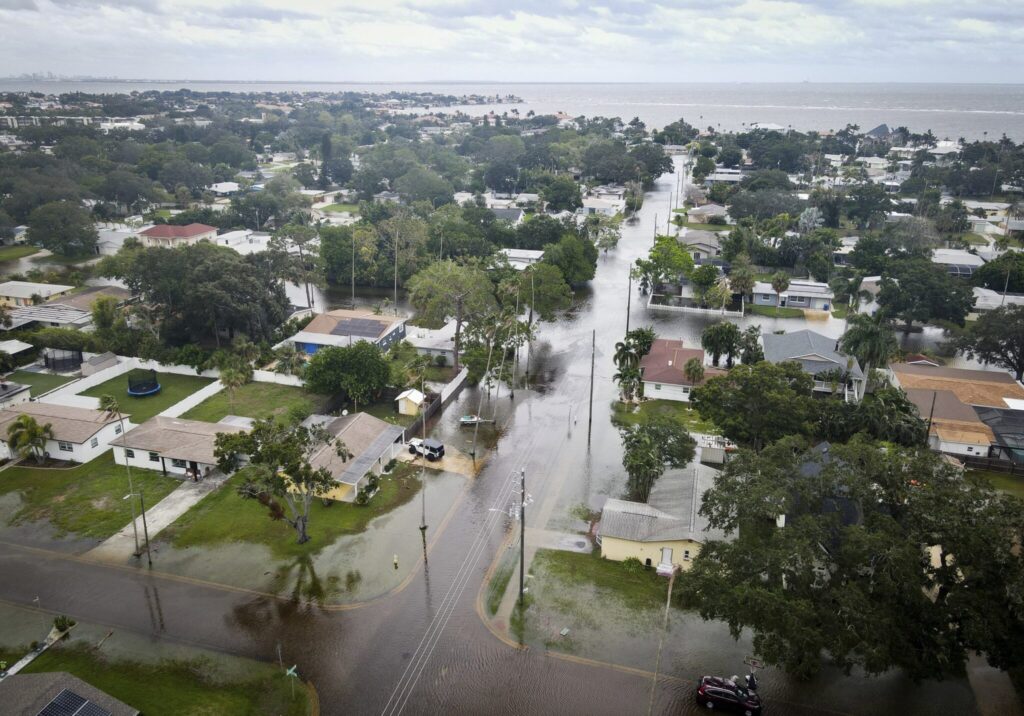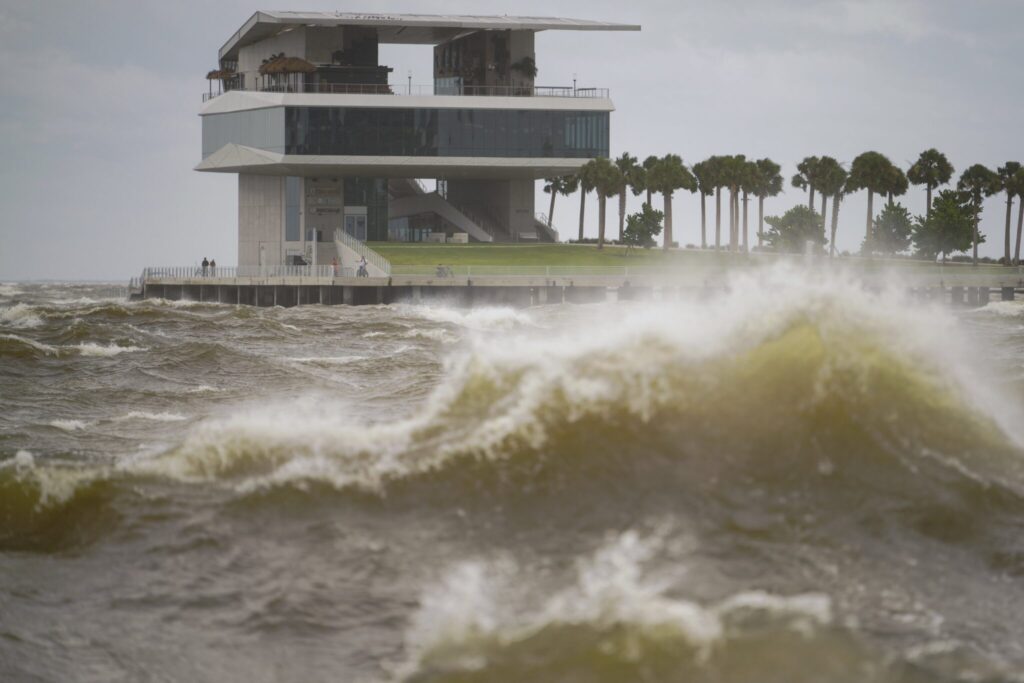Hurricane Helene landfall/ Helene devastates South/ Helene storm impacts/ Newslooks/ CRAWFORDVILLE/ Fla./ J Mansour/ Morning Edition/ Hurricane Helene made landfall in northwestern Florida as a Category 4 storm, causing widespread destruction, flooding, and power outages across the southeastern U.S. As the storm weakened to a tropical storm over Georgia, at least four storm-related deaths were reported. Over 3 million people remain without power, and authorities continue rescue operations for those trapped by floodwaters.

Helene’s Southern Impact: Quick Looks
- Category 4 Landfall: Helene made landfall near the Aucilla River in Florida with 140 mph winds, causing major damage.
- Widespread Power Outages: Over 3 million homes across Florida, Georgia, and the Carolinas were left without electricity.
- Flooding and Rescues: Floodwaters trapped residents in several areas, prompting emergency rescues.
- Deaths Reported: At least four people have died due to storm-related incidents, including a tornado in Georgia.
- Storm’s Path: Helene weakened to a tropical storm over Georgia and is expected to bring heavy rain and potential mudslides to the Appalachian Mountains.
Helene Weakens After Category 4 Landfall, Leaving Destruction
Deep Look
Hurricane Helene, one of the most powerful storms of the 2024 Atlantic hurricane season, slammed into northwestern Florida late Thursday, unleashing catastrophic winds, torrential rain, and a deadly storm surge. The storm, which made landfall as a Category 4 hurricane, wreaked havoc across the southeastern United States, cutting power to millions and leaving entire communities underwater.
A Destructive Landfall in Florida
Helene roared ashore near the mouth of the https://www.newslooks.com/fast-moving-hurricane-helene-targets-florida-with-high-winds/. Thursday with winds peaking at 140 mph (225 kph), according to the National Hurricane Center. This area, a quiet region known for its fishing villages and natural beauty, faced near-total devastation as the powerful winds and storm surge battered homes, flipped over buildings, and flooded roads.
The storm’s intensity was described as a “nightmare” by officials, and communities like Perry, Florida, located near where the storm made landfall, were hit particularly hard. Social media videos showed siding ripped from buildings and entire homes overturned by the force of the winds. Taylor County, where Perry is located, experienced widespread power outages, with crews struggling to access the hardest-hit areas.
In Citrus County, further south, rescue operations began early Friday morning as first responders used boats to evacuate residents trapped by rapidly rising floodwaters. The local sheriff’s office issued a dire warning, urging people not to wade through floodwaters that may be contaminated with live wires, sewage, and sharp debris.
Millions Without Power Across the Southeast
The storm knocked out power to more than 3 million homes and businesses across Florida, Georgia, and the Carolinas. As of early Friday, more than 1.2 million homes in Florida, 900,000 in Georgia, and nearly 927,000 in the Carolinas were in the dark. Power outages were so extensive that many areas are expected to remain without electricity for days, if not longer.
The sheer scale of the power outages mirrored the devastation seen during Hurricane Idalia, which struck the same region a year ago. For residents of Valdosta, Georgia, where Helene’s eye passed on Thursday night, this marks the third storm in just over a year, following Idalia and Tropical Storm Debby. Many in the area huddled in shelters or darkened hotel lobbies as hurricane-force winds tore through the city, damaging homes and businesses.
Rescue Operations and Casualties
Emergency officials scrambled to save lives as the storm’s effects became clear. In addition to flooding and wind damage, tornadoes spawned by Helene caused fatalities. In south Georgia, two people were killed when a suspected tornado touched down, while in https://www.newslooks.com/fast-moving-hurricane-helene-targets-florida-with-high-winds/ a falling tree claimed the life of another victim. In Florida, a person died after a sign collapsed onto their car during the height of the storm.
Governor Ron DeSantis of Florida warned that more deaths and extensive damage were likely to emerge as the state began to assess the full extent of the destruction. “When Floridians wake up tomorrow morning, we’re going to be waking up to a state where very likely there’s been additional loss of life and certainly there’s going to be loss of property,” DeSantis said in a late-night briefing.
Helene’s Path: From Florida to the Appalachian Mountains
After making landfall in Florida, Helene quickly moved inland, weakening to a tropical storm by early Friday morning as it crossed into Georgia. The storm, with maximum sustained winds of 70 mph (110 kph), was about 40 miles east of Macon, Georgia, and continued to move north at 30 mph.
The National Hurricane Center reported that the storm would gradually weaken as it moved toward Tennessee and Kentucky but warned of continued heavy rainfall that could lead to flash floods and mudslides in the Appalachian Mountains. The forecast called for up to 14 inches (36 centimeters) of rain in some areas, particularly in the mountainous regions of North Carolina and Tennessee, where flash flood warnings remain in effect.
Emergency Responses and Warnings
States across the southeastern U.S. were in emergency mode, with Georgia, Alabama, Virginia, and the Carolinas all declaring states of emergency in preparation for Helene’s wrath. Evacuations were ordered in many areas, and curfews were implemented to protect residents and emergency personnel from the dangers of downed trees, power lines, and flooded roads.
Georgia Governor Brian Kemp described Helene as “one of the biggest storms we’ve ever had” and urged residents to remain indoors and stay off the roads as rescue teams worked to reach those in need. Throughout the night, state parks were opened to evacuees, and shelters were filled with displaced families, some bringing along their pets and even horses.
A Storm of Historic Proportions
Helene’s impacts extend far beyond the U.S. The storm left parts of Mexico’s Yucatan Peninsula flooded earlier in the week, with streets in the resort city of Cancun underwater and trees toppled across the region. In Cuba, over 200,000 homes lost power as the hurricane passed by the island, adding to the already significant destruction caused in the Caribbean.
With this being the eighth named storm of the 2024 Atlantic hurricane season, meteorologists point to record-warm ocean temperatures as a key factor in Helene’s rapid intensification. The National Oceanic and Atmospheric Administration (NOAA) had already predicted an above-average hurricane season, and Helene’s unprecedented strength and scale seem to confirm those warnings.
As the storm continues its northward journey, residents in its path are bracing for more flooding, mudslides, and damage. With over 1,300 miles of destruction left in its wake, Hurricane Helene will likely be remembered as one of the most devastating storms to hit the southeastern U.S. in recent memory.







